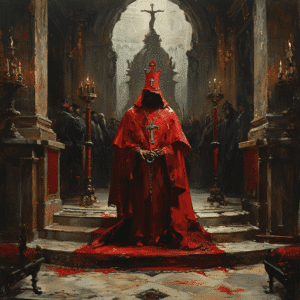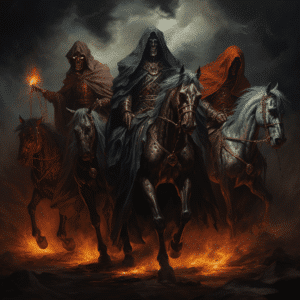
Left Behind and Beyond: Exploring the Rise of the Antichrist in Modern Media
By GZR News on January 1, 2024
The Antichrist theme, with its mysterious and captivating nature, is widely featured in various media, drawing audience attention with its intrigue. From ancient religious texts to modern-day popular culture, the Antichrist has fascinated and intrigued people for centuries.
This article examines the Antichrist’s increasing presence in modern media, exploring its origins, psychological impact, controversies, and related debates.

Key Takeaways
- The Antichrist mythology has evolved from ancient religious texts to becoming a prominent figure in modern popular culture.
- The fear factor associated with the Antichrist captivates our imagination, making it a symbol of rebellion and power.
- Interpreting the Antichrist from different perspectives leads to controversies and debates surrounding its existence and influence.
- The Antichrist has made its way into various forms of media, including literature, movies, music, art, video games, and comics, reflecting societal anxieties and cultural interpretations.
- The concept of the Antichrist is deeply rooted in Christian eschatology and end times prophecies, contributing to its enduring presence in modern media.
The Origins of the Antichrist Mythology
Ancient Religious Texts and Prophecies
The concept of the Antichrist has its roots in ancient religious texts and prophecies. In these texts, there are references to a figure who will rise to power and oppose the forces of good. Christian eschatology, which is the study of the end times, has also played a significant role in shaping the mythology of the Antichrist. The idea of a powerful and malevolent figure who will bring about the end of the world has captured the imagination of people for centuries. This mythology has evolved, with different interpretations and depictions of the Antichrist in literature.

The Influence of Christian Eschatology
In Christian eschatology, the Antichrist is believed to be a figure who will rise to power in the end times and deceive many. This belief has influenced the portrayal of the Antichrist in literature throughout history.
One example of the Antichrist in literature is the character of Damien Thorn in the novel ‘The Omen‘ by David Seltzer. Damien is portrayed as the son of Satan and is destined to bring about the apocalypse. This portrayal draws on the biblical prophecies of the Antichrist and adds a modern twist.
Another influential work is ‘Paradise Lost‘ by John Milton, which presents the story of Lucifer’s fall from grace and his role as the ultimate antagonist to God. This epic poem explores the themes of rebellion and the corrupting influence of power, which are often associated with the Antichrist.
The influence of Christian eschatology on the portrayal of the Antichrist in literature highlights the enduring fascination with this figure and its symbolic significance in exploring themes of good versus evil, power, and the end of the world.
The Evolution of the Antichrist in Literature
The concept of the Antichrist has a long history in literature, dating back to ancient religious texts and prophecies. In these texts, the Antichrist is often portrayed as a figure of evil and destruction, who will bring about the end of the world. Christian eschatology, which focuses on the study of the end times, has also played a significant role in shaping the portrayal of the Antichrist in literature. Over time, the depiction of the Antichrist in literature has evolved, reflecting the changing beliefs and fears of society.
In early literature, the Antichrist was often depicted as a powerful and charismatic leader who would deceive people with his charm and false promises. However, as society became more secular and skeptical, the portrayal of the Antichrist shifted to emphasize his dark and malevolent nature. In modern literature, the Antichrist is often portrayed as a symbol of rebellion and power, representing the darker aspects of human nature.
The evolution of the Antichrist in literature mirrors the evolution of society’s fears and anxieties. As societal concerns change, so does the portrayal of the Antichrist. From ancient religious texts to modern novels, the Antichrist continues to captivate our imagination and serve as a reflection of our deepest fears and desires.
The Antichrist in Popular Culture
From Books to Movies: The Antichrist’s Journey
 The portrayal of the Antichrist has made its way from the pages of books to the big screen, captivating audiences with its dark and intriguing storyline. Movies like ‘The Omen’ and ‘Rosemary’s Baby‘ have brought the Antichrist to life, showcasing the battle between good and evil in a thrilling and suspenseful way. These films have not only entertained viewers but have also sparked discussions and debates about the nature of evil and the role of the Antichrist in popular culture.
The portrayal of the Antichrist has made its way from the pages of books to the big screen, captivating audiences with its dark and intriguing storyline. Movies like ‘The Omen’ and ‘Rosemary’s Baby‘ have brought the Antichrist to life, showcasing the battle between good and evil in a thrilling and suspenseful way. These films have not only entertained viewers but have also sparked discussions and debates about the nature of evil and the role of the Antichrist in popular culture.
In addition to movies, the Antichrist has also found its way into television series, such as ‘American Horror Story: Apocalypse‘ and ‘Good Omens’. These shows have further explored the mythology surrounding the Antichrist, delving into themes of power, temptation, and the ultimate battle between heaven and hell. With their captivating storylines and complex characters, these TV series have contributed to the ongoing fascination with the Antichrist in modern media.
The journey of the Antichrist from books to movies and TV shows is a testament to its enduring appeal and the timeless fascination with the battle between good and evil. Whether portrayed as a charismatic leader or a terrifying force, the Antichrist continues to captivate our imagination and challenge our beliefs about the nature of evil.
The Antichrist in Music and Art
Music and art often express complex emotions, and the Antichrist theme is a prime example. In music, it symbolizes rebellion and explores evil and temptation, with bands like Black Sabbath and Marilyn Manson using it to shock and provoke. In art, the Antichrist appears in different styles, from paintings to sculptures, exploring good versus evil and often depicted as powerful and seductive. This theme in music and art challenges us to think about evil and human nature.
The Antichrist in Video Games and Comics
Video games and comics have also embraced the concept of the Antichrist, offering unique and interactive experiences for audiences. In video games, players can take on the role of the Antichrist or face off against this formidable antagonist. Games like ‘Darksiders’ and ‘Devil May Cry’ explore the dark and supernatural themes associated with the Antichrist, immersing players in epic battles between good and evil.
Comics, on the other hand, have delved into the Antichrist mythology through iconic characters like ‘Hellboy’ and ‘Spawn’. These comics depict the Antichrist as a complex and morally ambiguous figure, challenging traditional notions of good and evil. The visual storytelling and intricate plotlines in comics allow for a deeper exploration of the Antichrist’s character and the consequences of their actions.
>> Get GROUND ZERO: AFTERMATH – Support more articles like this.
The Psychological Appeal of the Antichrist
The Fear Factor: Why the Antichrist Captivates Our Imagination
The concept of the Antichrist has long been a source of fear and fascination. It taps into our deepest anxieties about the end of the world and the battle between good and evil. The idea of a powerful and charismatic figure who embodies pure evil captures our imagination and keeps us on the edge of our seats. From biblical prophecies to modern literature and movies, the Antichrist has become a popular and enduring symbol of darkness and destruction. Whether it’s the fear of the unknown or the thrill of exploring the darker side of human nature, the Antichrist continues to captivate audiences around the world.
The Antichrist as a Symbol of Rebellion and Power
 The concept of the Antichrist has long been associated with rebellion and power. In popular culture, the Antichrist is often portrayed as a charismatic and influential figure who challenges authority and seeks to overthrow the established order. This portrayal taps into our fascination with rebellion and our desire to see the underdog rise up against the powers that be.
The concept of the Antichrist has long been associated with rebellion and power. In popular culture, the Antichrist is often portrayed as a charismatic and influential figure who challenges authority and seeks to overthrow the established order. This portrayal taps into our fascination with rebellion and our desire to see the underdog rise up against the powers that be.
One example of this portrayal can be found in the podcast ‘The Secret Teachings with Ryan Gable‘. In an episode titled ‘The Antichrist: A Symbol of Rebellion and Power’, Gable explores the historical and cultural significance of the Antichrist archetype. He delves into the origins of the myth and its evolution in literature, as well as its psychological appeal to individuals and society as a whole.
Gable argues that the Antichrist represents the ultimate symbol of rebellion and power, embodying our collective desire for freedom and the overthrow of oppressive systems. By examining the Antichrist myth through a cultural and psychological lens, Gable sheds light on why this archetype continues to captivate our imagination and provoke intense debates and controversies.
The Antichrist as a Reflection of Societal Anxieties
The concept of the Antichrist has long been a source of fascination and fear in popular culture. It serves as a reflection of societal anxieties, tapping into our deepest fears and concerns. Through various mediums such as literature, movies, music, and video games, the Antichrist embodies the collective unease of a society grappling with its own uncertainties.
The portrayal of the Antichrist often highlights themes of rebellion and power. This figure represents a force that challenges established norms and authority, appealing to those who feel marginalized or oppressed. The Antichrist becomes a symbol of defiance and liberation, offering a sense of empowerment to individuals who may feel powerless in their own lives.
Moreover, the Antichrist serves as a mirror to societal anxieties. It reflects the fears and uncertainties of a particular time and place. Whether it’s political unrest, economic instability, or cultural shifts, the Antichrist embodies these concerns and magnifies them, providing a cathartic outlet for individuals to confront and process their own anxieties.
In conclusion, the Antichrist’s enduring presence in modern media is a testament to its psychological appeal. It taps into our deepest fears, offers a sense of rebellion and power, and reflects the anxieties of our society. By exploring the rise of the Antichrist in popular culture, we gain insight into the collective psyche and the cultural landscape of our time.

Controversies and Debates Surrounding the Antichrist
Interpreting the Antichrist: Different Perspectives
When it comes to interpreting the Antichrist, there are various perspectives that people hold. Some view the Antichrist as a literal figure who will rise to power in the end times, while others see it as a symbolic representation of evil and corruption. One interesting perspective is presented by Jeremy Scott in his podcast Into the Parabnormal with Jeremy Scott. Scott explores the idea that the Antichrist is not a single individual, but rather a collective consciousness that manifests in different forms throughout history. This perspective challenges traditional interpretations and offers a fresh take on the Antichrist mythos.
In his podcast, Scott delves into the historical and cultural context surrounding the Antichrist, examining how different societies and belief systems have shaped the concept. He explores the idea that the Antichrist is not limited to any specific religion or culture, but is a universal archetype that transcends boundaries. Scott’s unique perspective sheds light on the complexity and diversity of interpretations surrounding the Antichrist.
While some may dismiss these alternative perspectives as mere speculation, they provide valuable insights into the human fascination with the Antichrist. By exploring different viewpoints, we can gain a deeper understanding of the psychological and sociological factors that contribute to the enduring popularity of the Antichrist in modern media and culture.
The Antichrist in Conspiracy Theories
Conspiracy theories have always been a part of popular culture, and the Antichrist is no exception. Some conspiracy theorists believe that powerful individuals or secret societies are working behind the scenes to bring about the rise of the Antichrist. They claim that these individuals manipulate world events, control governments, and use symbolism to communicate their plans. While these theories may seem far-fetched to some, they have gained a significant following and continue to spark debates and discussions.
One popular conspiracy theory suggests that the Antichrist will rise to power through a global government or New World Order. Supporters of this theory point to various historical events and symbols as evidence of a hidden agenda. They argue that the Antichrist will use technology, surveillance, and mind control to establish a totalitarian regime.
It’s important to note that these conspiracy theories are not supported by mainstream scholars or experts. They are often based on speculation, misinterpretation of religious texts, and a distrust of authority. However, they serve as a fascinating example of how the Antichrist mythos has captured the imagination of some individuals and fueled their beliefs.
The Antichrist and the End Times Prophecies
 The concept of the Antichrist is closely tied to end times prophecies, which predict a period of great turmoil and the ultimate battle between good and evil. In various religious texts and beliefs, the Antichrist is seen as a figure who will rise to power and deceive many, leading humanity astray. This idea has captured the imagination of people throughout history and has been depicted in various forms of media.
The concept of the Antichrist is closely tied to end times prophecies, which predict a period of great turmoil and the ultimate battle between good and evil. In various religious texts and beliefs, the Antichrist is seen as a figure who will rise to power and deceive many, leading humanity astray. This idea has captured the imagination of people throughout history and has been depicted in various forms of media.
One of the most well-known end times prophecies is found in the book of Revelation in the Bible. It describes the rise of the Antichrist as a charismatic leader who will gain a large following and bring about chaos and destruction. This prophecy has been interpreted and reimagined in different ways by different religious groups and scholars.
In popular culture, the Antichrist is often portrayed as a powerful and sinister figure who embodies evil and rebellion. They are depicted as having supernatural abilities and a charismatic personality that attracts followers. This portrayal reflects the fear and fascination that people have with the idea of a figure who can challenge the established order and bring about the end of the world.
The Antichrist and end times prophecies have also been the subject of numerous conspiracy theories. Some believe that powerful individuals or secret societies are working towards the rise of the Antichrist and the fulfillment of these prophecies. These theories often involve complex interpretations of historical events and symbols, adding to the intrigue and mystery surrounding the Antichrist.
While the concept of the Antichrist and end times prophecies may be controversial and debated among different religious and cultural groups, it continues to captivate our imagination and spark discussions about the nature of good and evil, the future of humanity, and the ultimate fate of the world.
Conclusion
In conclusion, the rise of the Antichrist in modern media has captivated audiences and sparked intriguing discussions about the portrayal of evil and the end times. From literature to film and television, the concept of the Antichrist continues to be a compelling and thought-provoking subject. As society grapples with the complexities of good and evil, the Antichrist remains a symbol of fear, fascination, and controversy. It is clear that the Antichrist narrative will continue to evolve and influence popular culture for years to come.